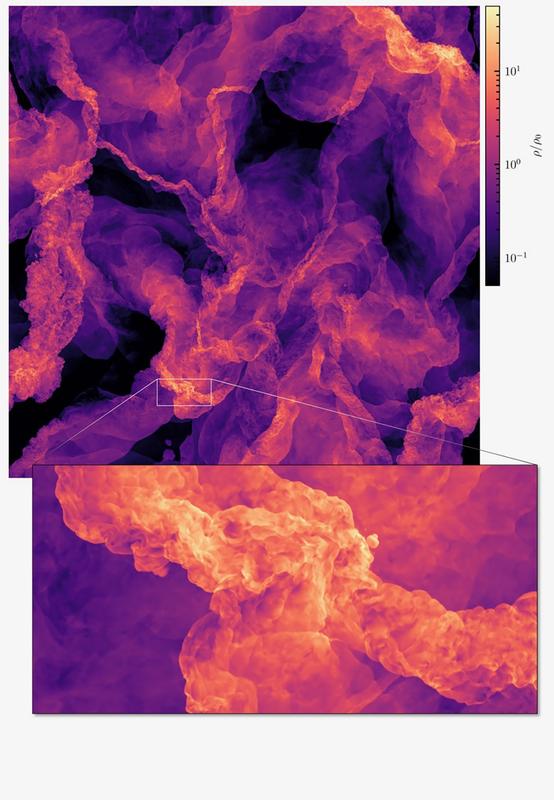The Role of Turbulence in the Birth of Stars

Excerpt from the computer simulation: The illustration shows a turbulence inside an interstellar gas cloud
Bild: Christoph Federrath et al.
Heidelberg astrophysicists study interstellar gas clouds as part of an international cooperation
Computer simulations of turbulence in interstellar gas and molecular clouds – simulations so complex they were inconceivable until now – have provided important new insights into the role turbulence plays in the formation of stars. For the first time, the results of the calculations suggest how these turbulent movements transition from the supersonic to the subsonic range. The work was conducted by an international research team led by scientists from the Centre for Astronomy of Heidelberg University and the Australian National University, Canberra. The simulations were carried out at the Leibniz Supercomputing Centre of the Bavarian Academy of Sciences and Humanities.
When and how interstellar gas clouds form stars are among astronomy’s key and most complex questions. “Interstellar gas, which makes up about ten to 15 percent of the visible matter in the Milky Way, does not uniformly penetrate the space between the stars, but in its distribution rather resembles rising and turbulent swirling smoke. And it is precisely this turbulent behaviour that is the key to understanding how interstellar gas clouds fragment and contract under their own gravitational weight to form stars and star clusters,” explains Prof. Dr Ralf Klessen of the Institute of Theoretical Astrophysics, which is part of the Centre for Astronomy of Heidelberg University.
These turbulent movements pose a particular challenge for research in that they tend to cascade from larger scales to smaller and smaller ones. They are similar to billows of smoke with their large, rapidly moving eddies and the smaller eddies that are carried along with them. This cascading process also takes place in the gas, dust and molecular clouds between the stars, known as the interstellar medium. According to Prof. Klessen, however, these clouds are many orders of magnitude “thinner” than a plume of smoke.
In this cascade, the turbulent energy decreases to a smaller and smaller scale, causing the large areas of turbulence, mostly moving at supersonic speed, to eventually move at subsonic speed. And it is precisely this transition – known as the sonic scale – that determines the properties of dense molecular cloud cores. This scale is believed to mark the transition zone from turbulence-dominated to gravity-dominated behavior. Once gravity dominates, star formation sets in.
“There are, of course, theoretical predictions as to where this transition zone should be. But its exact location, shape and width were previously unknown. The physical processes are so tremendously complex that they can only be studied with the help of computer simulations,” adds Prof. Klessen. As part of an international cooperation, the Heidelberg researcher and his colleague Prof. Dr Christoph Federrath from the Australian National University used resources from the Leibniz Supercomputing Centre to carry out the largest simulation of interstellar turbulence to date to study the transition from supersonic to subsonic turbulence.
Prof. Federrath describes the results as spectacular. The researchers not only confirmed the theoretically predicted position of the sonic scale but also determined the width and shape of the transition zone from the supersonic to the subsonic range. The transition is not sharp but occurs over a wide range of scale. “Theoretically, this transition zone defines the frequency with which new stars can be found in interstellar gas clouds,” explains Ralf Klessen. “We have therefore compared our prediction with observations of gas clouds in the Milky Way and obtained excellent agreement with their statistical properties,” continues the Heidelberg astrophysicist. From the point of view of the scientists, the simulations will be able to provide quantitative information for future turbulence-regulated models of star formation.
The research results were published in the journal Nature Astronomy.
Contact:
Communications and Marketing
Press Office
Phone +49 6221 54-2311
presse@rektorat.uni-heidelberg.de
Wissenschaftliche Ansprechpartner:
Prof. Dr Ralf S. Klessen
Institute for Theoretical Astrophysics
Phone +49 6221 54-8978
klessen@uni-heidelberg.de
Originalpublikation:
C. Federrath, R. S. Klessen, L. Lapichino, J. R. Beattie: The sonic scale of interstellar turbulence. Nature Astronomy (2021), doi: 10.1038/s41550-020-01282-z
Weitere Informationen:
http://www.ita.uni-heidelberg.de/research/klessen/people/klessen/index.shtml?lan…
Media Contact
All latest news from the category: Physics and Astronomy
This area deals with the fundamental laws and building blocks of nature and how they interact, the properties and the behavior of matter, and research into space and time and their structures.
innovations-report provides in-depth reports and articles on subjects such as astrophysics, laser technologies, nuclear, quantum, particle and solid-state physics, nanotechnologies, planetary research and findings (Mars, Venus) and developments related to the Hubble Telescope.
Newest articles

Innovative 3D printed scaffolds offer new hope for bone healing
Researchers at the Institute for Bioengineering of Catalonia have developed novel 3D printed PLA-CaP scaffolds that promote blood vessel formation, ensuring better healing and regeneration of bone tissue. Bone is…

The surprising role of gut infection in Alzheimer’s disease
ASU- and Banner Alzheimer’s Institute-led study implicates link between a common virus and the disease, which travels from the gut to the brain and may be a target for antiviral…

Molecular gardening: New enzymes discovered for protein modification pruning
How deubiquitinases USP53 and USP54 cleave long polyubiquitin chains and how the former is linked to liver disease in children. Deubiquitinases (DUBs) are enzymes used by cells to trim protein…


